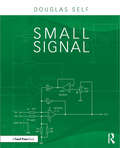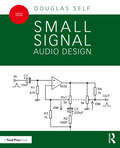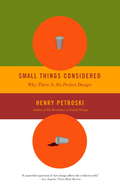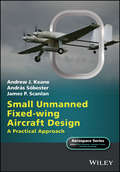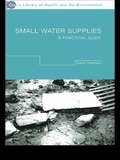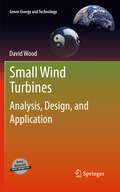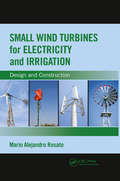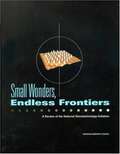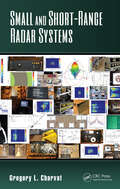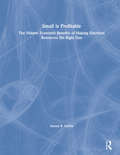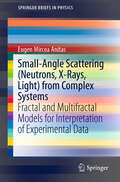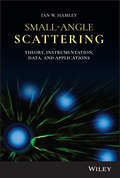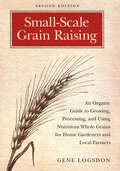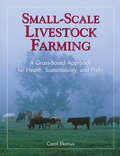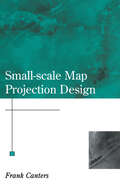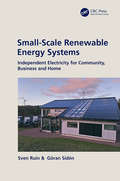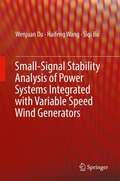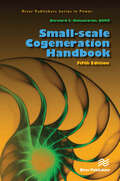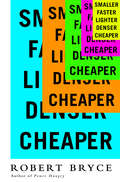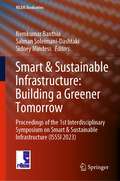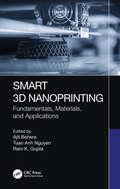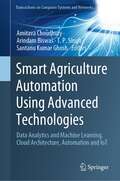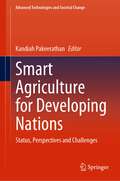- Table View
- List View
Small Signal Audio Design
by Douglas SelfLearn to use inexpensive and readily available parts to obtain state-of-the-art performance in all the vital parameters of noise, distortion, crosstalk and so on. With ample coverage of preamplifiers and mixers and a new chapter on headphone amplifiers, this practical handbook provides an extensive repertoire of circuits that can be put together to make almost any type of audio system. A resource packed full of valuable information, with virtually every page revealing nuggets of specialized knowledge not found elsewhere. Essential points of theory that bear on practical performance are lucidly and thoroughly explained, with the mathematics kept to a relative minimum. Douglas' background in design for manufacture ensures he keeps a wary eye on the cost of things. Includes a chapter on power-supplies, full of practical ways to keep both the ripple and the cost down, showing how to power everything. Douglas wears his learning lightly, and this book features the engaging prose style familiar to readers of his other books. You will learn why mercury cables are not a good idea, the pitfalls of plating gold on copper, and what quotes from Star Trek have to do with PCB design. Learn how to: make amplifiers with apparently impossibly low noise design discrete circuitry that can handle enormous signals with vanishingly low distortion use humble low-gain transistors to make an amplifier with an input impedance of more than 50 Megohms transform the performance of low-cost-opamps, how to make filters with very low noise and distortion make incredibly accurate volume controls make a huge variety of audio equalisers make magnetic cartridge preamplifiers that have noise so low it is limited by basic physics sum, switch, clip, compress, and route audio signals The second edition is expanded throughout (with added information on new ADCs and DACs, microcontrollers, more coverage of discrete op amp design, and many other topics), and includes a completely new chapter on headphone amplifiers.
Small Signal Audio Design
by Douglas SelfSmall Signal Audio Design is a highly practical handbook providing an extensive repertoire of circuits that can be assembled to make almost any type of audio system. This fully revised fourth edition offers wholly new content on internally balanced audio design, electret microphones, emitter-follower stability, microphony in capacitors, and much, much more. This book continues the engaging prose style familiar to readers as you learn why mercury-filled cables are not a good idea, the pitfalls of plating gold on copper, and what quotes from Star Trek have to do with PCB design. Learn how to: make amplifiers with apparently impossibly low noise design discrete circuitry that can handle enormous signals with vanishingly low distortion transform the performance of low-cost opamps build active filters with very low noise and distortion while saving money on expensive capacitors make incredibly accurate volume controls make a huge variety of audio equalisers use load synthesis to make magnetic cartridge preamplifiers that have noise so low it is limited by basic physics sum, switch, clip, compress, and route audio signals build simple but ultra-low noise power supplies be confident that phase perception is not an issue. Including all the crucial theories, but with minimal mathematics, Small Signal Audio Design is the must-have companion for anyone studying, researching, or working in audio engineering and audio electronics.
Small Things Considered: Why There Is No Perfect Design
by Henry PetroskiEven everyday objects that most people never think of as having been designed, says Petroski (civil engineering and history, Duke U.), remain works in progress. He points out that objects change with age and use, people change in their needs and wants, and the environment changes, so no design is more than an approximation for a particular time, place, and purpose. Annotation (c)2003 Book News, Inc., Portland, OR (booknews.com)
Small Unmanned Aircraft: Theory and Practice
by Randal W. Beard Timothy W. McLainAutonomous unmanned air vehicles (UAVs) are critical to current and future military, civil, and commercial operations. Despite their importance, no previous textbook has accessibly introduced UAVs to students in the engineering, computer, and science disciplines--until now. Small Unmanned Aircraft provides a concise but comprehensive description of the key concepts and technologies underlying the dynamics, control, and guidance of fixed-wing unmanned aircraft, and enables all students with an introductory-level background in controls or robotics to enter this exciting and important area. The authors explore the essential underlying physics and sensors of UAV problems, including low-level autopilot for stability and higher-level autopilot functions of path planning. The textbook leads the student from rigid-body dynamics through aerodynamics, stability augmentation, and state estimation using onboard sensors, to maneuvering through obstacles. To facilitate understanding, the authors have replaced traditional homework assignments with a simulation project using the MATLAB/Simulink environment. Students begin by modeling rigid-body dynamics, then add aerodynamics and sensor models. They develop low-level autopilot code, extended Kalman filters for state estimation, path-following routines, and high-level path-planning algorithms. The final chapter of the book focuses on UAV guidance using machine vision. Designed for advanced undergraduate or graduate students in engineering or the sciences, this book offers a bridge to the aerodynamics and control of UAV flight.
Small Unmanned Fixed-wing Aircraft Design: A Practical Approach
by Andrew J. Keane Andras Sobester James P. ScanlanSmall Unmanned Fixed-wing Aircraft Design is the essential guide to designing, building and testing fixed wing UAVs (or drones). It deals with aircraft from two to 150 kg in weight and is based on the first-hand experiences of the world renowned UAV team at the UK’s University of Southampton. The book covers both the practical aspects of designing, manufacturing and flight testing and outlines and the essential calculations needed to underpin successful designs. It describes the entire process of UAV design from requirements definition to configuration layout and sizing, through preliminary design and analysis using simple panel codes and spreadsheets to full CFD and FEA models and on to detailed design with parametric CAD tools. Its focus is on modest cost approaches that draw heavily on the latest digital design and manufacturing methods, including a strong emphasis on utilizing off-the-shelf components, low cost analysis, automated geometry modelling and 3D printing. It deliberately avoids a deep theoretical coverage of aerodynamics or structural mechanics; rather it provides a design team with sufficient insights and guidance to get the essentials undertaken more pragmatically. The book contains many all-colour illustrations of the dozens of aircraft built by the authors and their students over the last ten years giving much detailed information on what works best. It is predominantly aimed at under-graduate and MSc level student design and build projects, but will be of interest to anyone engaged in the practical problems of getting quite complex unmanned aircraft flying. It should also appeal to the more sophisticated aero-modeller and those engaged on research based around fixed wing UAVs.
Small Water Supplies: A Practical Guide
by David ClaphamThere are approximately 50,000 small water supplies in the UK alone, and thousands more worldwide. Dealing with the idiosyncratic characteristics of small water supplies requires specialist knowledge, and this book provides invaluable guidance for professionals.Based on the extensive practical experience of the author, this book covers how small independent supplies differ from public water supplies, and outlines the health dangers they pose, along with detailed instruction in water sampling and risk assessment techniques. Clapham describes the different types of water supplies including their construction and treatment systems, and discusses common problems encountered. A wide range of case studies bring the theory to life, and both UK and European legislation is discussed. There is also a sizeable section dealing with small water supplies in developing countries.
Small Wind Turbines
by David WoodSmall Wind Turbines provides a thorough grounding in analysing, designing, building, and installing a small wind turbine. Small turbines are introduced by emphasising their differences from large ones and nearly all the analysis and design examples refer to small turbines. The accompanying software includes MATLAB® programs for power production and starting performance, as well as programs for detailed multi-objective optimisation of blade design. A spreadsheet is also given to help readers apply the simple load model of the IEC standard for small wind turbine safety. Small Wind Turbines represents the distilled outcome of over twenty years experience in fundamental research, design and installation, and field testing of small wind turbines. Small Wind Turbines is a suitable reference for student projects and detailed design studies, and also provides important background material for engineers and others using small wind turbines for remote power and distributed generation applications.
Small Wind Turbines for Electricity and Irrigation: Design and Construction
by Mario Alejandro RosatoThis practical book deals with the technology of small-power wind turbines as opposed to widely diffused industrial wind turbines and wind farms. It covers the most common wind turbine technologies in the small power segment: horizontal axis both for electrical generation and water pumping, vertical axis of the Darrieus type, and vertical axis of the Savonius type. With each chapter following the same didactic scheme—a theoretical explanation and practical examples showing calculation procedures—it allows anybody with basic technical knowledge to design and build a small wind turbine for any site. A set of simple spreadsheets is available for download, each providing further examples of how to solve specific design problems and allowing the reader to play with changing parameters and see what-if. This simple trial-and-error learning process allows beginners to develop the feeling of the orders of magnitude involved in the design of a small wind power system, its potential advantages on other alternative solutions, and its limitations under some special circumstances.
Small Wonders, Endless Frontiers: A Review of the National Nanotechnology Initiative
by Committee for the Review of the National Nanotechnology InitiativeA Review of the National Nanotechnology Initiative
Small and Short-Range Radar Systems (Modern And Practical Approaches To Electrical Engineering Ser. #1)
by Gregory L. CharvatRadar Expert, Esteemed Author Gregory L. Charvat on CNN and CBSAuthor Gregory L. Charvat appeared on CNN on March 17, 2014 to discuss whether Malaysia Airlines Flight 370 might have literally flown below the radar. He appeared again on CNN on March 20, 2014 to explain the basics of radar, and he explored the hope and limitations of the technology i
Small is Profitable: The Hidden Economic Benefits of Making Electrical Resources the Right Size
by Amory B. LovinsToday's electricity industry - large power stations feeding a nationwide grid - will soon be a thing of the past. This book explains why and what will replace it - decentralized and distributed electrical resources which can be up to 10 times as economically valuable. The authors - all leading experts in the field - explain very clearly and thoroughly all the benefits, so the engineers will understand the economic advantages and the investors will understand the engineering efficiencies. Here's what industry experts are saying about Small is Profitable... 'A tour-de-force and a goldmine of good ideas. It is going to have a stunning impact on thinking about electricity.' Walter C. Patterson, Senior Research Fellow, Royal Institute of International Affairs, London. 'An amazing undertaking - incredibly ambitious yet magnificently researched and executed.' Dr. Shimon Awerbuch, Senior Advisor, International Energy Agency, Paris. 'Outstanding...You have thought of some [benefits] I never considered...A great resource for the innovation in energy services that will have to take place for us to have a sustainable future.' Dr. Carl Weinberg, Weinberg Associates, former Research Director, PG&E. 'This is a brilliant synthesis and overview with a lot of original analytics and insights and a very important overall theme. I think it is going to have a big impact.' Greg Kats, Principal, Capital E LLC, former Finance Director for Efficiency and Renewable Energy, U.S. Department of Energy. 'E. F. Schumacher would be proud of this rigorous extension of his thesis in Small is Beautiful. It shows how making systems the right size can make them work better and cost less. Here are critical lessons for the new century: technologies tailored to the needs of people, not the reverse, can improve the economy and the environment.' Dr. Daniel Kammen, Professor of Energy and Society and of Public Policy, University of California, Berkeley. 'Small is Profitable creates an unconventional but impeccably reasoned foundation to correctly assign the costs and true benefits of distributed energy systems. It has become an indispensable tool for modelling distributed energy systems benefits for us.' Tom Dinwoodie, CEO and Chairman, PowerLight Corporation. 'A Unique and valuable contribution to the distributed energy industry...Small Is Profitable highlights the societal benefits of distributed resources, and will be a helpful guide to policymakers who wish to properly account for these benefits in the marketplace.' Nicholas Lenssen, Senior Director, Primen. 'This book will shift the electric industry from the hazards of overcentralization toward the new era where distributed generation will rule.' Steven J. Strong, President, Solar Design Associates, Inc. 'Readers will understand why distributed resources are poised to fundamentally alter the electric power system. Its comprehensive review of the benefits of distributed resources [is] an important part of my library.' Dr. Thomas E. Hoff, President, Clean Power Research. 'The most comprehensive treatise on distributed generation.... Great job and congratulations.' Howard Wenger, Principal, Pacific Energy Group '..[D]ensely packed with information and insights...goes a long way to demonstrate that the former paradigm of electric power supply no longer makes sense.' Prof. Richard Hirsh, University of Vermont, Leading historian of the electric power sector. 'Amory Lovins was already the world's most original and influential thinker on the future of energy services in general and electricity systems in particular. This remarkable book is a very worthy addition to an extraordinary legacy.' Ralph Cavanagh, Energy Co-Director, Natural Resources Defense Council. 'This is a book every utility professional should have on the bookshelf.' Dr Peter S. Fox-Penner, Principal and Chairman of the Board, the Brattle Group, former Principal Deputy Assistant Secretary of Energy.
Small-Angle Scattering: Fractal and Multifractal Models for Interpretation of Experimental Data (SpringerBriefs in Physics)
by Eugen Mircea AnitasThis book addresses the basic physical phenomenon of small-angle scattering (SAS) of neutrons, x-rays or light from complex hierarchical nano- and micro-structures. The emphasis is on developing theoretical models for the material structure containing self-similar or fractal clusters. Within the suggested framework, key approaches for extracting structural information from experimental scattering data are investigated and presented in detail. The range of parameters which can be obtained pave the road towards a better understanding of the correlations between geometrical and various physical properties (electrical, magnetic, mechanical, optical, dynamical, transport etc.) in fractal nano- and micro-materials.
Small-Angle Scattering: Theory, Instrumentation, Data, and Applications
by Ian W. HamleySMALL-ANGLE SCATTERING A comprehensive and timely volume covering contemporary research, practical techniques, and theoretical approaches to SAXS and SANSSmall-Angle Scattering: Theory, Instrumentation, Data, and Applications provides authoritative coverage of both small-angle X-ray scattering (SAXS), small-angle neutron scattering (SANS) and grazing incidence small-angle scattering (GISAS) including GISAXS and GISANS. This single-volume resource offers readers an up-to-date view of the state of the field, including the theoretical foundations, experimental methods, and practical applications of small-angle scattering (SAS) techniques including laboratory and synchrotron SAXS and reactor/spallation SANS.Organized into six chapters, the text first describes basic theory, instrumentation, and data analysis. The following chapters contain in-depth discussion on various applications of SAXS and SANS and GISAXS and GISANS, and on specific techniques for investigating structure and order in soft materials, biomolecules, and inorganic and magnetic materials. Author Ian Hamley draws from his more than thirty years’ experience working with many systems, instruments, and types of small-angle scattering experiments across most European facilities to present the most complete introduction to the field available. This book:Presents uniquely broad coverage of practical and theoretical approaches to SAXS and SANSIncludes practical information on instrumentation and data analysisOffers useful examples and an accessible and concise presentation of topicsCovers new developments in the techniques of SAXS and SANS, including GISAXS and GISANSSmall-Angle Scattering: Theory, Instrumentation, Data, and Applications is a valuable source of detailed information for researchers and postgraduate students in the field, as well as other researchers using X-ray and neutron scattering to investigate soft materials, other nanostructured materials and biomolecules such as proteins.
Small-Scale Gas to Liquid Fuel Synthesis
by Nick KanellopoulosIt is estimated that a large fraction of natural gas reserves are found in locations from where transport is not economical. If these isolated natural gas reserves could be converted to synthetic fuels, they would generate around 250 billion barrels of synthetic oil-a quantity equal to one-third of the Middle East's proven oil reserves. Small-Scale
Small-Scale Grain Raising: An Organic Guide to Growing, Processing, and Using Nutritious Whole Grains for Home Gardeners and Local Farmers, 2nd Edition
by Gene LogsdonFirst published in 1977, this book—from one of America&’s most famous and prolific agricultural writers—became an almost instant classic among homestead gardeners and small farmers. Now fully updated! Small-Scale Grain Raising offers a entirely new generation of readers the best introduction to a wide range of both common and lesser-known specialty grains and related field crops, from corn, wheat, and rye to buckwheat, millet, rice, spelt, flax, and even beans and sunflowers.More and more Americans are seeking out locally grown foods, yet one of the real stumbling blocks to their efforts has been finding local sources for grains, which are grown mainly on large, distant corporate farms. At the same time, commodity prices for grains—and the products made from them—have skyrocketed due to rising energy costs and increased demand. In this book, Gene Logsdon proves that anyone who has access to a large garden or small farm can (and should) think outside the agribusiness box and learn to grow healthy whole grains or beans—the base of our culinary food pyramid—alongside their fruits and vegetables.Starting from the simple but revolutionary concept of the garden &“pancake patch,&” Logsdon opens up our eyes to a whole world of plants that we wrongly assume only the agricultural &“big boys&” can grow. He succinctly covers all the basics, from planting and dealing with pests, weeds, and diseases to harvesting, processing, storing, and using whole grains. There are even a few recipes sprinkled throughout, along with more than a little wit and wisdom.Never has there been a better time, or a more receptive audience, for this book. Localvores, serious home gardeners, CSA farmers, and whole-foods advocates—in fact, all people who value fresh, high-quality foods—will find a field full of information and ideas in this once and future classic."Home bakers rejoice! Gene's book is back just in time to help you grow those flavorful, old, heirloom grain varieties you have always wanted to try. Bon appétit!"—Eliot Coleman, author of The Winter Harvest Handbook and The New Organic Grower
Small-Scale Livestock Farming: A Grass-Based Approach for Health, Sustainability, and Profit
by Carol EkariusFull of practical everyday advice, this guide explains how a natural, organic approach to livestock farming produces healthy animals, reduces costs, and increases your operation&’s self-sufficiency. Livestock expert Carol Ekarius helps you create a viable farm plan, choose suitable livestock, care for your animals&’ health, and confidently manage housing, fencing, and feeding. Case studies of successful farmers provide inspiration as you learn everything you need to know to run a prosperous livestock farm and make the lifestyle of your dreams a reality. This publication conforms to the EPUB Accessibility specification at WCAG 2.0 Level AA.
Small-Scale Map Projection Design
by Frank CantersThe use of computers in cartography has made it easier for map makers to transform data from one map projection to another and experiment with alternative representations of geographical data. This has created new challenges and opportunities for map projection scientists. Small Scale Map Projection Design focuses on numerical map projection research and is written from the perspective of the map projection user. It demonstrates how advances in the measurement of map projection distortion and in the development of low error map projections can help map makers decide what type of map projection is best for their purpose, and shows how they can eventually design their own map projections.
Small-Scale Renewable Energy Systems: Independent Electricity for Community, Business and Home
by Sven Ruin Göran SidénA revolution is ongoing in the field of small-scale energy solutions, which can enable lower impact on the environment, more robust supply and self-determination. Solar power and other forms of renewable energy sources, which you can implement to generate your own electricity, are growing quickly. Electromobility is transforming the car industry and transportation systems and can also play a role in your energy system. Electricity can be used much more efficiently than before, for example by using LED light, variable speed motor drives and efficient home appliances. Smart controls are available, sometimes with free open source software. All this opens up tremendous opportunities for energy independence, which is the focus of this book. The book introduces the reader to a number of renewable energy sources, to different options for storing electricity and to smart use of electricity, particularly in the context of small isolated systems. This is important because many renewable energy sources are weather- and season-dependent and usually require storage and smart control, in order to obtain a system that is completely independent of the electricity grid. In the book, overall system design is explained, including how to combine different sources in a hybrid system. Different system sizes and architectures are also covered. A number of real cases are described, where homes, businesses and communities have achieved a high level of energy independence or are on their way to achieving it. This book will prove useful in university education in renewable energy at bachelor and master level, and also for companies and private individuals, who want to start or expand activities in the area of renewable energy.
Small-Signal Stability Analysis of Power Systems Integrated with Variable Speed Wind Generators
by Haifeng Wang Wenjuan Du Siqi BuThis book reviews and examines how power system low-frequency power oscillations and sub-synchronous oscillations may be affected by grid connection of wind power generation. Grid connection of wind power generation affects the power system small-signal stability and has been one of the most actively pursued research subjects in power systems and power electronics engineering in the last ten years. This book is the first of its kind to cover the impact of wind power generation on power system low-frequency oscillations and sub-synchronous oscillations. It begins with a comprehensive overview of the subject and progresses to modeling of power systems and introduces the application of conventional methods, including damping torque analysis, modal analysis and frequency-domain analysis, presented with detailed examples, making it useful for researchers and engineers worldwide.
Small-scale Cogeneration Handbook
by Bernard F. KolanowskiCogeneration can now turn up to 90% of the fuel burned into usable energy – compared to just 52% of the fuel typically burned in a local power plant and in a separate existing hot water heating system. The fifth edition of this comprehensive reference provides a wealth of information to assist you in evaluating the feasibility and potential benefits of cogeneration for your facility. Covered are recent regulatory developments and their impact, system selection and sizing, permitting requirements, operation and maintenance, financing, technology basics, micro turbines, absorption chillers, distributed generation, and numerous case histories. This new edition is updated with new material and comes with access to a useful program that can help determine the economic value of applying cogeneration for your clients’ benefit.
Smaller Faster Lighter Denser Cheaper: How Innovation Keeps Proving the Catastrophists Wrong
by Robert BryceIn the face of today's environmental and economic challenges, doomsayers preach that the only way to stave off disaster is for humans to reverse course: to de-industrialize, re-localize, ban the use of modern energy sources, and forswear prosperity. But in this provocative and optimistic rebuke to the catastrophists, Robert Bryce shows how innovation and the inexorable human desire to make things Smaller Faster Lighter Denser Cheaper is providing consumers with Cheaper and more abundant energy, Faster computing, Lighter vehicles, and myriad other goods. That same desire is fostering unprecedented prosperity, greater liberty, and yes, better environmental protection.Utilizing on-the-ground reporting from Ottawa to Panama City and Pittsburgh to Bakersfield, Bryce shows how we have, for centuries, been pushing for Smaller Faster solutions to our problems. From the vacuum tube, mass-produced fertilizer, and the printing press to mobile phones, nanotech, and advanced drill rigs, Bryce demonstrates how cutting-edge companies and breakthrough technologies have created a world in which people are living longer, freer, healthier, lives than at any time in human history.The push toward Smaller Faster Lighter Denser Cheaper is happening across multiple sectors. Bryce profiles innovative individuals and companies, from long-established ones like Ford and Intel to upstarts like Aquion Energy and Khan Academy. And he zeroes in on the energy industry, proving that the future belongs to the high power density sources that can provide the enormous quantities of energy the world demands.The tools we need to save the planet aren't to be found in the technologies or lifestyles of the past. Nor must we sacrifice prosperity and human progress to ensure our survival. The catastrophists have been wrong since the days of Thomas Malthus. This is the time to embrace the innovators and businesses all over the world who are making things Smaller Faster Lighter Denser Cheaper.
Smart & Sustainable Infrastructure: Proceedings of the 1st Interdisciplinary Symposium on Smart & Sustainable Infrastructure (ISSSI 2023) (RILEM Bookseries #48)
by Sidney Mindess Nemkumar Banthia Salman Soleimani-DashtakiThis book gathers peer-reviewed contributions presented at the 1st Interdisciplinary Symposium on Smart & Sustainable Infrastructure (ISSSI), held in Vancouver, BC, Canada, on September 4–8, 2023, and affiliated with the 77th RILEM Annual Week 2023. Aiming at creating an environment of mutual cooperation between experts in materials and structures, it covers topics such as sensors, IoT, and structural health monitoring, AI and machine learning, data analytics for infrastructure management, nanotechnology, additive manufacturing, smart and bioinspired materials, durability of materials and structures, resilience to earthquakes, floods, fire and blast, carbon reduction in construction and operations, and sustainable ultra-high performance materials. The contributions, which were selected through a rigorous international peer-review process, share exciting ideas that will spur novel research directions and foster new multidisciplinary collaborations.
Smart 3D Nanoprinting: Fundamentals, Materials, and Applications
by Ajit Behera Ram K. Gupta Tuan Anh NguyenExamining smart 3D printing at the nanoscale, this book discusses various methods of fabrication, the presence of inherent defects and their annihilation, property analysis, and emerging applications across an array of industries. The book serves to bridge the gap between the concept of nanotechnology and the tailorable properties of smart 3D-print products. FEATURES Covers surface and interface analysis and smart technologies in 3D nanoprinting Details different materials, such as polymers, metals, semiconductors, glassceramics, and composites, as well as their selection criteria, fabrication, and defect analysis at nanoscale Describes optimization and modeling and the effect of machine parameters on 3D-printed products Discusses critical barriers and opportunities Explores emerging applications in manufacturing industries, such as aerospace, healthcare, automotive, energy, construction, and defense Smart 3D Nanoprinting: Fundamentals, Materials, and Applications is aimed at advanced students, researchers, and industry professionals in materials, manufacturing, chemical, and mechanical engineering. This book offers readers a comprehensive overview of the properties, opportunities, and applications of smart 3D nanoprinting.
Smart Agriculture Automation Using Advanced Technologies: Data Analytics and Machine Learning, Cloud Architecture, Automation and IoT (Transactions on Computer Systems and Networks)
by Arindam Biswas T. P. Singh Amitava Choudhury Santanu Kumar GhoshThis book addresses the challenges for developing and emerging trends in Internet-of-Things (IoT) for smart agriculture platforms. It also describes data analytics & machine learning, cloud architecture, automation & robotics and aims to overcome existing barriers for smart agriculture with commercial viability. It discusses IoT-based monitoring systems for analyzing the crop environment, and methods for improving the efficiency of decision-making based on the analysis of harvest statistics. The book explores a range of applications including intelligent field monitoring, intelligent data processing and sensor technologies, predictive analysis systems, crop monitoring, and weather data-enabled analysis in IoT agro-systems. This volume will be helpful for engineering and technology experts and researchers, as well as for policy-makers.
Smart Agriculture for Developing Nations: Status, Perspectives and Challenges (Advanced Technologies and Societal Change)
by Kandiah PakeerathanThis book in its eighteen chapters provides sustainable and smart technology-based solutions to developing nations. Smart farming is growing in importance due to the increasing demand for higher crop yield, the need for using natural resources efficiently, the rising use and sophistication of information and communication technology and the increasing need for climate-smart agriculture. Some of these chapters deal with the applications of smart agriculture to address the special challenges of the Small Island Developing States for sustainable agriculture. The book brings together scientific communities from India, Indonesia, Iraq, Malaysia, Mauritius, Myanmar, Palestine, Sri Lanka and South Africa to share their expertise to make the farming system more connected and intelligent. The smart farming techniques shared in different chapters not only help to reduce the overall cost and improve the quality and quantity of products but altogether help improve the sustainability of agriculture in the developing world.‘Smart Farming’ is a management concept focused on providing the agricultural industry with the infrastructure to leverage advanced technologies—including artificial intelligence (AI), big data, robotics, drones and Internet of Things (IoT)—for tracking, monitoring, automating and analyzing operations. Sometimes known as precision agriculture, smart farming is software managed and sensor monitored.
